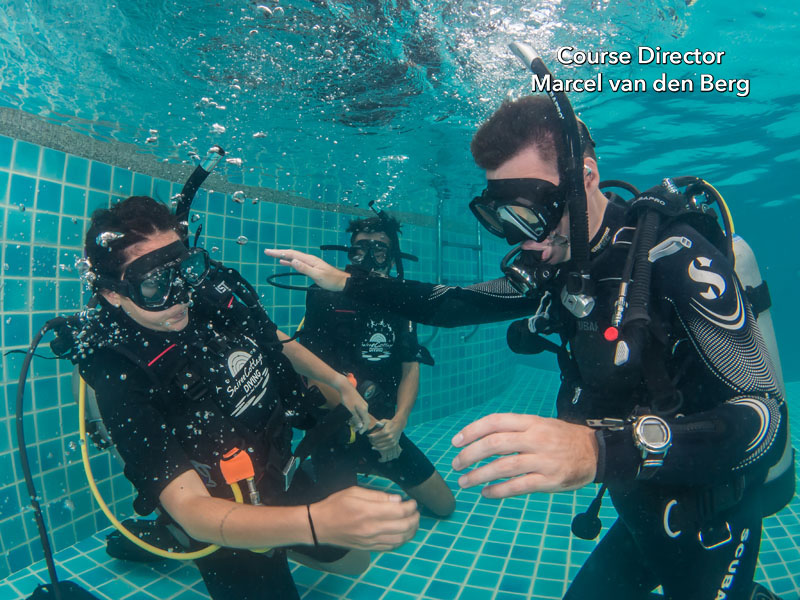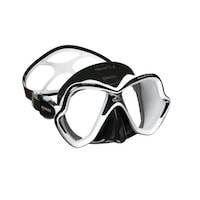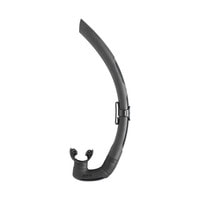PADI Confined Water Dive 1
PADI Confined Water Dive 1 is the first time for most people to experience scuba diving. PADI Confined Water Dive 1 is part of the PADI Open Water Diver Course. In total there are 5 separate PADI Confined Water Dives that you can also combine (in order) if you want to.
Combine or Not Combine PADI Confined Water Dives
Combining or not combining Confined Water Dives depends mostly on the location of where you are doing your PADI Open Water Course. In Europe for example you will in most cases do the PADI Confined Water Dives separately. This is because people work or go to school and they can only do small parts of the Open Water Diver course in the evenings and weekends. In this case you would do PADI Confined Water Dive 1 on a Monday evening, followed by Confined Water Dive 2 on a Friday evening.
In places like Asia for example most people are on holiday and don't have these time restrictions, so they can combines confined dives to save time and to speed up the course. In Europe an PADI Open Water course can take around 6 weeks compared to Asia where it can be done in 3 to 5 days. Depending on the Dive Instructor the quality is the same, just different schedules.
In places like Asia for example most people are on holiday and don't have these time restrictions, so they can combines confined dives to save time and to speed up the course. In Europe an PADI Open Water course can take around 6 weeks compared to Asia where it can be done in 3 to 5 days. Depending on the Dive Instructor the quality is the same, just different schedules.
Do I have to worry about PADI Confined Water Dive 1?
We understand that it is normal to be nervous about your first scuba diving experience. However, we can tell you right now that for most new scuba divers these nerves will go away soon. Scuba Diving and breathing underwater is surprisingly easy, once your mind accepts the new feeling or breathing underwater.
This is the reason for Confined Water, they don't just trow you in the sea for the first time and ask to do a skill at like 53m of depth. First we practice in the shallow water of confined (pool or open water with pool like conditions) and then when you are comfortable you move slowly to deeper water and repeat some of the scuba skills.
This is the reason for Confined Water, they don't just trow you in the sea for the first time and ask to do a skill at like 53m of depth. First we practice in the shallow water of confined (pool or open water with pool like conditions) and then when you are comfortable you move slowly to deeper water and repeat some of the scuba skills.
Do I have to neutrally buoyant in confined dive 1 or can I kneel?
This has been a major debate for year between Divemasters and Diving Instructors. We believe it depends a lot on the situation, how many students, your comfort level, confined water dive location and so much more. Please check out this article wrote about Neutrally Buoyant vs Kneeling in Scuba Diving.
Organisation of PADI Confined Water Dive 1
Every PADI Diving Instructor has their own styles and teaches a bit different. But all Dive Instructors need to follow PADI Standards. In the PADI Instructor manual is states that you have to complete all the performance requirements of PADI Confined Water Dive 1 before you move onto Confine Dive 2.
A typical organisation of Confined Dive 1 would that you start with learning how to set up your dive equipment, learn how to do a buddy check, enter the water, practice some surface skills, practice some scuba skills in shallow water, move to deeper water, finish surface skills, exit the water and finally disassemble your dive equipment.
A typical organisation of Confined Dive 1 would that you start with learning how to set up your dive equipment, learn how to do a buddy check, enter the water, practice some surface skills, practice some scuba skills in shallow water, move to deeper water, finish surface skills, exit the water and finally disassemble your dive equipment.
PADI Confined Water Dive 1 Skills
- Dive Equipment Assembly
- Put on dive equipment using proper technique
- Buddy Check
- Inflate/Deflate BCD at the Surface
- Regulator Clearing Two Methods
- Regulator Removal & Recovery
- Partially Flooded Mask
- Alternate Air Source Stationary for 30 Seconds
- Controlled Descent Shallow to Deep
- Swim Maintaining Buoyancy
- Air Check
- Ascent Using Proper Technique
- Inflating BCD at the Surface
- Snorkelling
- Orally Inflate the BCD at the Surface
- Exit the Water
- Disassemble Dive Equipment
Should I purchase my own Dive Equipment or Rent?
As you are starting out with your first scuba diving experience you have 3 options for dive equipment. You can rent (included in the diving course price), buy a few dive equipment items or buy a full set of dive gear.
What you choose depends mostly on your budget, but one thing is clear. Owning you own dive gear is much better as it is clean, you know all the features, in most cases better serviced, looks better and you don't have to share. Especially if you are a bit nervous to go scuba diving we highly recommend to purchase your own dive gear.
However, if you budget is low we recommend to add least buy your own scuba mask as that will help you a lot with the mask clearing skills. Below we have selected a set of dive gear and a scuba mask we highly recommend for beginner scuba divers:
What you choose depends mostly on your budget, but one thing is clear. Owning you own dive gear is much better as it is clean, you know all the features, in most cases better serviced, looks better and you don't have to share. Especially if you are a bit nervous to go scuba diving we highly recommend to purchase your own dive gear.
However, if you budget is low we recommend to add least buy your own scuba mask as that will help you a lot with the mask clearing skills. Below we have selected a set of dive gear and a scuba mask we highly recommend for beginner scuba divers:
|
|
|
|
Marcel van den Berg
PADI Platinum Course Director
PADI Platinum Course Director
SCUBA DIVING TIPS
Privacy Policy
Disclaimer
As an Amazon Associate I earn from qualifying purchases.
All content on this website and URL are owned by Sairee Cottage Diving PADI 5-Star IDC Center S-36452
Copyright 2017 - 2022 | All Rights Reserved
Disclaimer
As an Amazon Associate I earn from qualifying purchases.
All content on this website and URL are owned by Sairee Cottage Diving PADI 5-Star IDC Center S-36452
Copyright 2017 - 2022 | All Rights Reserved





